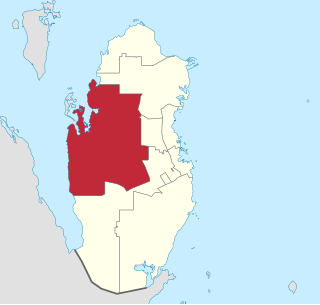
Since 2015, Qatar has been divided into eight municipalities. In 2004, a new municipality, Al Daayen, was created under Resolution No. 13, formed from parts of Umm Salal and Al Khawr; at the same time, Al Ghuwariyah was merged with Al Khawr; Al Jumaliyah was merged with Ar Rayyan; Jarayan al Batnah was split between Al Rayyan and Al Wakrah; and Mesaieed was merged with Al Wakrah. In 2014, the western city of Al-Shahaniya split off from Al Rayyan Municipality to form its own municipality.

Al Rayyan is the third-largest municipality in the state of Qatar. Its primary settlement is the city of the same name, which occupies the entire eastern section and is a part of the Doha Metropolitan Area. The vast expanse of mostly undeveloped lands in the south-west also falls under the municipality's administration.

Al Gharrafa is a Qatari district of Al Rayyan City, which is located in the municipality of Al Rayyan. In close proximity to Education City and constituting a part of the Doha Metropolitan Area, the Doha Expressway and Al Shamal Highway run along the district. Many malls operate out of the area. To the east, it neighbors the largely residential areas of Duhail and Madinat Khalifa North, therefore Al Gharrafa is largely a retail hub for nearby residential areas. Doha's downtown is 10 kilometres (6.2 mi) to the southeast.

Al Shahaniya is a municipality (3299 km2) in Qatar, with its municipal seat being a city of the same name (39 km2). Formerly in the municipality of Al Rayyan, but now an independent municipality, the municipal seat was delimited in 1988 by Law No. 22. In 2014, the cabinet ratified a draft amending provisions to the 1988 law that formalized Al Shahaniya as Qatar's eighth municipality.

New Al Hitmi is a Qatari district located in the municipality of Ad Dawhah. The name is derived from the Al-Hitmi family, which is a branch of the main Al Bin Ali tribe. Together with Fereej Bin Omran and Hamad Medical City, it forms Zone 37, which has a population of 26,121.

Dukhan is a city in the western municipality of Al-Shahaniya in Qatar. It is approximately 80 kilometres (50 mi) west of the capital, Doha. Dukhan is administered by Qatar's state oil agency QatarEnergy and is the site of the first oil discovery in Qatar. It was previously a part of Al Rayyan municipality.

Al Karaana is a Qatari village located in the municipality of Al Rayyan. It used to be part of the Jariyan Al Batnah municipality before the municipality was incorporated into Al Rayyan. It is situated around 60 kilometres (37 mi) to the south-west of the capital Doha.

Rawdat Rashed is a village in Qatar, located in the municipality of Al-Shahaniya. It was demarcated in 1988. It used to be part of the Jariyan Al Batnah municipality before the municipality was incorporated into Al Rayyan. In 2014, the village was incorporated into the newly created Al-Shahaniya Municipality.

Mebaireek is a settlement in Qatar, located in the municipality of Al Rayyan. It was formalized as one of Al Rayyan's ten administrative zones in the mid-2000s following the merger of the two census-designated districts of Abu Nakhla and Al Mukaynis. Al Mukaynis, which is known for Mudhlem Cave, is still in Zone 81 with Mebaireek whereas Abu Nakhla has moved to Al-Shahaniya Municipality.

Al Jemailiya is a town in the municipality of Al-Shahaniya, Qatar. It used to be the seat of Al Jemailiya Municipality before it was incorporated into Al Rayyan Municipality in 2004. In 2014, the town was incorporated into the newly created Al-Shahaniya Municipality. The town lies roughly 30 km north-west of the Al-Shahaniya Exit of Dukhan Highway. It has been designated a District Centre for Al-Shahaniya Municipality, meaning that it is being developed to serve the needs of nearby communities, such as Al Suwaihliya.

Al Messila is a Qatari district in the municipality of Doha. For the most part, large gated compounds and schools occupy this district. It shares its western border with Lebday and Old Al Rayyan in Al Rayyan Municipality.

Umm Salal Ali is the seat of the municipality of Umm Salal in Qatar.
Umm Birka is a settlement in the Al Khor municipality of Qatar.

Abu Hamour is a Qatari district in the municipality of Al Rayyan. Known to some as the "Wholesale Market District", it is a part of the Doha Metropolitan Area.

Ad-Dawhah is one of the eight municipalities of Qatar. It is the most populous municipality with a population of 1,186,023 in 2020, and is the municipality of Qatar's capital city, Doha.

Al-Shahaniya City is a city in Qatar, located in the similarly named municipality of Al-Shahaniya.

Al-Rayyan is a city in the similarly named municipality of Al Rayyan, in Qatar. The city and its suburbs comprise the largest population center in Qatar outside of Doha proper, immediately to its east. Consisting of all of the districts in the municipality's easternmost section, its western boundary is roughly where the Al Majd Highway runs through the municipality. The city is a part of the Doha Metropolitan Area. It was one of the venues for the 2022 FIFA World Cup.
Al Hemaila is a district in Qatar, located in the municipality of Al Rayyan.
Madinat Al Mawater is a planned community of Rawdat Rashed in the Al-Shahaniya Municipality, central Qatar. Its first phase of construction was launched in May 2016. The community will occupy an area of 1.15 km2 and have a developed area of 167,072 m2.


















